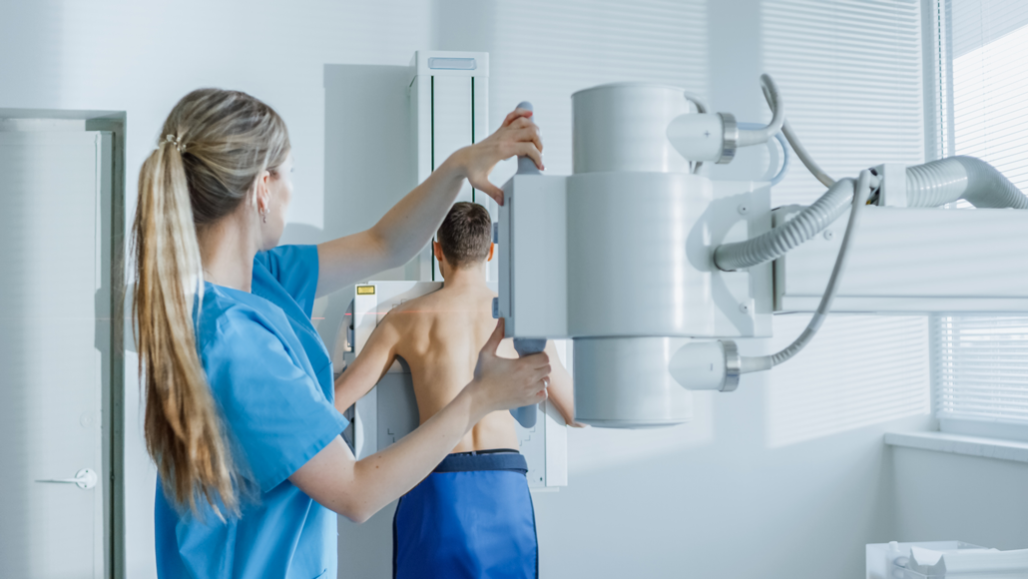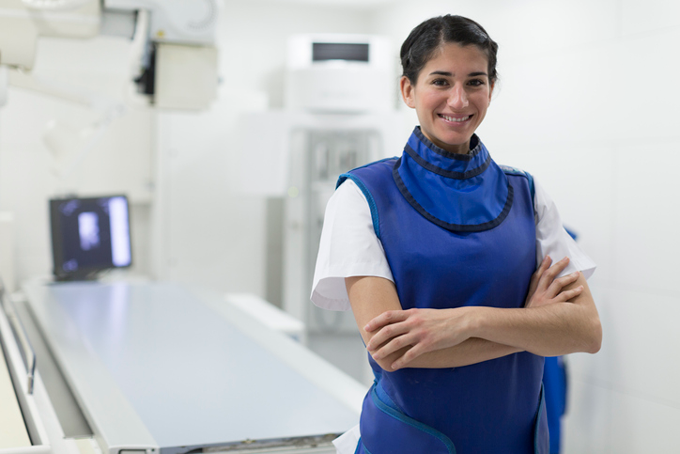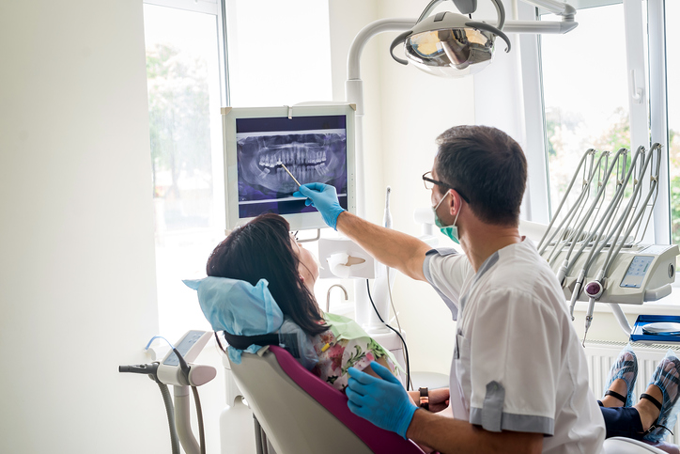Experts rethink need for X-ray shielding of patients
The lead 'aprons' used may not offer much protection and could degrade imaging quality, they say

Man wears a lead apron (covered in blue fabric) as he is prepped for X-rays. Radiation experts are now talking about ending the practice of using such protective shielding.
gorodenkoff/iStock/Getty Images Plus
CHICAGO, Ill. — Plenty of people get X-rays. X-rays are used to image everything from broken bones and internal disorders to gum disease. Today, most technicians will drape part of your torso with a heavy lead apron as they prep you for the scan. Its purpose: to block X-rays from hitting parts of the body that may be harmed by radiation. These can include your reproductive organs. But many experts have begun talking about abandoning this lead shielding. Why? It doesn’t really help, they charge.
Several major medical and science groups say that lead shielding may harm the quality of the scans. It may even lead some X-ray machines to mistakenly increase the X-ray dose a patient receives.
Since the 1950s, experts have called for lead shielding to protect the male sperm-forming organs (testicles) and a female’s egg-forming organs (ovaries). That recommendation was based on studies that suggested radiation might cause cell changes — mutations — that can lead to birth defects. Those studies were done in fruit flies. But biologists worried that X-rays might pose the same risks to people.
In the last 10 years, however, experts have been reviewing imaging technology and practices. They also undertook a deep dive into human health data.
What they found was that lead aprons can be hard to position well. This means they often don’t cover the targeted area. The aprons also may obscure things a doctor needs to see — the site of a swallowed object, for instance. This can lead them to take extra X-rays, according to the American Association of Physicists in Medicine. Its members work as physicists in hospitals.

Shields even can cause the automatic exposure controls on some X-ray machines to boost how much radiation they beam at unshielded tissues. This may happen as the controls try harder to “see through” a lead shield. Finally, no shielding can protect against “scatter.” That’s when radiation ricochets inside the body, including under the shield. Those scattered X-rays can leave a lot of energy in a patient’s tissues.
Perhaps a dozen U.S. hospitals have changed their official policy on lead aprons, reports Rebecca Marsh. She’s a medical physicist who works at the University of Colorado Anschutz Medical Campus in Aurora. Other U.S. hospitals, she adds, now “are starting to have the conversation.”
In December, she spoke about this issue at a forum here in Chicago. It was part of the annual meeting of the Radiological Society of North America. Groups of radiation experts in Canada and Australia also have endorsed a move to give up X-ray aprons, notes Marsh. Talk of doing away with lead shields is even underway in Great Britain.
But most people — from doctors to the public — are scared by the idea of radiation exposures. So giving up lead aprons, she notes, may provoke concerns “not only with patients but with staff.”
An evolving change
Last April, the physicists’ association issued a formal position statement. Patient shielding should be “discontinued as routine practice,” it said. Several other groups now agree. These include the American College of Radiology.
Also around the same time, the Food and Drug Administration proposed removing a federal recommendation that X-ray imaging centers use shielding. Its final rule on that is expected later this year.
The National Council on Radiation Protection and Measurements, or NCRP, is a U.S. group. It gives guidance to the government groups that write laws. NCRP also is expected to release a statement supporting the end of routine patient shielding later this year.
Cynthia Rigsby is a radiologist at Chicago’s Ann & Robert H. Lurie Children’s Hospital. Shielding is used for most of the 70,000 X-ray procedures performed each year at her hospital. It is now launching an “Abandon the Shield” campaign. Explains Rigsby, the campaign is to educate staff, patients and caregivers before the hospital ends shielding later this spring.

Educators and Parents, Sign Up for The Cheat Sheet
Weekly updates to help you use Science News Explores in the learning environment
Thank you for signing up!
There was a problem signing you up.
At the University of Chicago Medicine hospitals, the recommendation to stop shielding “came as kind of a shock,” says Kate Feinstein. She heads pediatric radiology there.
No shielding seems contrary to what she and other professionals had been taught, Feinstein notes. Her department already takes steps to reduce the chance that a shield will interfere with an exam. “We apply our shields correctly,” she says. “Our technologists are incredibly well trained,” she adds. But she said her department will look at the evidence and decide whether to stop shielding.
Some hospitals are concerned about violating state laws. As of spring 2019, at least 46 states, including Illinois, required lead shielding of reproductive organs if they were close to a body site being scanned with X-rays. Some states, however, have begun revising their laws.
No sign of benefits
With improved technology, today’s X-ray machines use only about one-twentieth as much radiation as they did in the 1950s. Biologists now find no sign of harm to ovaries and testicles in people getting diagnostic X-rays. They looked at decades of data.
“What we know now is that there is likely no [inherited] risk at all,” says Donald Frush. He’s a radiologist at Lucile Packard Children’s Hospital Stanford in Palo Alto, Calif. He also chairs a national group that promotes safe imaging in children.
There’s no evidence that even a fetus will be harmed by relatively high doses of X-rays in a pregnant woman, says Marsh. That includes CT scans of the abdomen, she notes. (Such scans take a series of images to create a 3-D image of internal organs).
Still, some patients may insist on a lead apron. And the physicists’ group says hospitals might want to make it an option when it would provide these patients “calm and comfort.”
Indeed, Frush says “I don’t think any of us are advocating to never use [shielding].”
What about dentists?
Most dental offices have not been on board with the no-shielding-needed idea. And that could confuse the public if dentists continue to shield their patients and hospitals don’t.

Back in 2016, U.S. imaging facilities produced an estimated 275 million medical X-ray exams. That same year, dental offices produced even more: 320 million X-rays of the mouth.
The American Dental Association now says that abdominal shielding “may not be necessary.” However, it still recommends using lead collars to shield the thyroid “whenever possible.”
Mahadevappa Mahesh is the chief physicist at Johns Hopkins Hospital in Baltimore, Md. He cautions that these lead collars may not be helpful and could obscure images taken by newer 3-D dental-imaging machines.
There’s been less outreach to dentists on how little lead shielding helps, he notes. “It’s high time we bring them into the discussion,” he concludes.
Kaiser Health News (KHN) is a nonprofit news service covering health issues. It is an editorially independent program of the Kaiser Family Foundation that is not affiliated with Kaiser Permanente.







